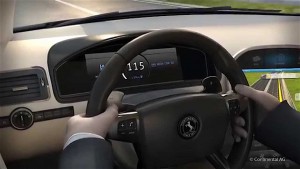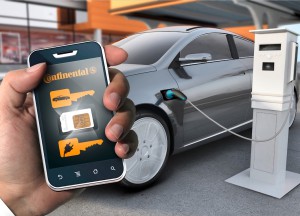
Continental's Cruising Chauffeur autonomous driving system allows motorists to let their vehicle handle the driving in certain conditions.
Continental AG is the latest company to offer up an autonomous driving solution with its “Cruising Chauffeur” system, which uses a mix of technologies to keep a vehicle cruising along the highway, adjusting to changing speed limits and driving conditions.
The system represents the continued technological evolution of the German-based supplier’s safety systems already in uses, such as blind-spot detection, adaptive cruise control and rear-cross-traffic alerts, re-shaping the motoring experience of millions of Americans.
Cruising Chauffeur is the next step in making roads safer, noted Jeremy McClain, director of systems and technology for Continental’s NAFTA region. He said 95% of all road accidents involve human error. Continental is working on systems that help limit the errors and reduce the number of fatalities and injuries, McClain said.
“We’re bringing more and more information,” he said.
However, the goal is also to reduce the workload on the driver, who already faces a plethora of challenges, noted McClain as Continental showed off some of the new technology it under development that cannot aid drivers but also serve as essential building blocks for automated vehicles.
When activated, the Cruising Chauffeur enables the vehicle to control all driving-related tasks, including lane changes by utilizing 360-degree radar and vision sensing, integrated into an active safety system with redundant and backup systems.

Continental joint venture OTA keys SA is developing a smart key that may play a role in the future growth of car sharing.
Continental Intelligent Transportation Systems, a business unit of Continental headquartered in Silicon Valley, presented a vehicle featuring “Road Database,” which provides accurate road data to advanced driver-assistance systems.
The basic idea behind it is for information to be taken from vehicle hardware sensors and used to generate a representation of the road almost instantaneously, giving an autonomous vehicle an accurate picture of the environment around a vehicle.
(Continental JV producing virtual keys. For more, Click Here.)
“With the implementation into the car and bringing Road Database to the streets, we are able to demonstrate how Road Database effectively supports the driver assistance systems in the vehicle by operating more conveniently and reliably with better predictive capabilities,” said Oers Teglasy, Product Manager at Continental ITS.
The advanced driver assistance systems currently available on vehicles require highly accurate information. In some cases, they include much more detailed attributes than just road geometry and lane guidance information. For example, variable speed limits, mobile construction sites and slope data.
Road Database helps to improve the driver assistance systems or optimize the engine output and for highly or fully automated driving that such road information becomes indispensable, Teglasy said.
The Road Database solution uses sensors already on modern vehicles such as cameras, radar and, to an increasing degree, lidar, are continuously recording a vast amount of the information required. The road data is first processed to extract features of the road in the Road Database format.
The in-vehicle Road Database software then compares this data against any information that may already be stored in the vehicle for the same piece of road. The newly identified differences are then anonymously and securely transmitted to the backend, operated by Continental to give the most accurate picture of road and guide the vehicle in all kinds of weather.
(Click Here for details on start up company’s $999 aftermarket self-driving system.)
The other systems under development at Continental include a vulnerable road protection system that would help prevent accidents with pedestrians and bicyclists who might be virtually invisible to the driver.
The other systems also include an electric parking brake for larger vehicles. The electric parking brakes work well on compact and midsize cars and the goal is to offer the system on vehicles such as pickup trucks, Continental officials said. Electric parking brakes important in the developing autonomous driving systems.
Continental also is refining features such as short-range radar, gesture control that can unlock lift gates and sliding doors and virtual keys that be used for car sharing.
Another future building block is an emergency steering assistance system that guides a vehicle around an obstacle. It can serve as extension or an alternative to forward collision braking systems now coming on line, Continental experts said.
Also under development at Continental is a Dynamic Horizon that can guide cars through green lights by offering guidance on the best speed for a long stretch of road.
McClain said some of the new technology has already being adapted by manufacturers. Alfa Romeo, for example, plans to equip the new Giulia with Continental’s MK C1 for the Integrated Brake System. It is the first time that the MK C1 electronic brake system enters series production worldwide.
(To see more about the Obama Administrations new rules for autonomous driving, Click Here.)
The system is more dynamic, lighter and more compact than conventional brake systems. In addition, it reduces pedal vibrations and the driver always feels the same force-path characteristics in the pedal, which provides a high level of comfort.
